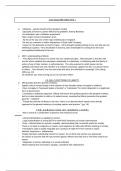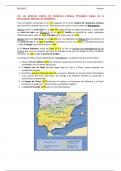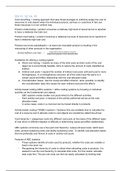Contents
1. Introduction to Finance for Entrepreneurs................................................................2
1.1 The Entrepreneurial Process...................................................................................................... 2
1.2 Entrepreneurship Fundamentals............................................................................................... 2
1.3 Sources of Entrepreneurial Opportunities..................................................................................3
1.4 Principles of Entrepreneurial Finance........................................................................................ 3
1.5 Role of Entrepreneurial Finance................................................................................................. 4
1.6 The Successful Venture Lifecycle.............................................................................................. 4
1.7 Financing Through the Venture Life Cycle.................................................................................5
2. Developing the Business idea...................................................................................6
2.1 Process for Identifying Business Opportunities..........................................................................6
2.2 Components of a Sound Business Model...................................................................................6
2.3 Best Practices of High-Growth and High-Performance Firms.....................................................6
2.4 Time-to-Market and other Timing Implications..........................................................................7
2.5 Initial Litmus Test for Evaluating the Business Feasibility of an Idea.........................................7
2.6 Screening Venture Opportunities............................................................................................... 7
2.8 Key Elements of a Business Plan............................................................................................... 8
3. Organising and Financing a New Venture..................................................................9
3.1 Progressing Through the Venture Life Cycle..............................................................................9
3.2 Forms of Business Organisation................................................................................................ 9
3.3 Choosing the Form of Organisation: Tax and Other Considerations.........................................10
3.4 Intellectual Property................................................................................................................ 10
3.5 Seed, Start-up, and First-Round Financing Sources.................................................................12
4. Preparing and Using Financial Statements..............................................................12
4.1 Obtaining and Recording the Resources Necessary to Start and Build a New Venture............12
4.2 Business Assets, Liabilities, and Owner’s Equity......................................................................12
4.3 Sales, Expenses, and Profts.................................................................................................... 12
4.4 Internal Operating Schedule.................................................................................................... 13
4.5 Statement of Cash Flows......................................................................................................... 13
4.6 Operating Breakeven Analyses................................................................................................ 13
5. Evaluating Operating and Financial Performance.....................................................15
5.1 Users of Operating and Financial Performance Measures by Life Cycle Stage.........................15
5.2 Using Financial Ratios.............................................................................................................. 15
5.3 Cash Burn Rates and Liquidity Ratios......................................................................................15
5.5 Proftability and Efciency Ratios............................................................................................ 16
5.7 A Guide to Financial Analysis................................................................................................... 16
6. Managing Cash Flow..............................................................................................17
6.1 Financial Planning Throughout the Venture’s Life Cycle..........................................................17
6.2 Surviving in the Short Run....................................................................................................... 17
6.3 Short-Term Cash-Planning Tools..............................................................................................17
6.4 Projected Monthly Financial Statements..................................................................................18
, 1
6.5 Cash Planning on a Projected Monthly Balance Sheet.............................................................18
6.6 Conversion Period Ratios......................................................................................................... 18
7. Types and Costs of Financial Capital.......................................................................20
7.1 Implicit and Explicit Financial Capital Costs.............................................................................20
7.2 Financial Markets..................................................................................................................... 20
7.3 Determining the Cost of Debt Capital......................................................................................20
7.4 Investment Risk....................................................................................................................... 21
7.5 Estimating the Cost of Equity Capital......................................................................................22
7.6 Weighted Average Cost of Capital...........................................................................................23
9. Projecting Financial Statements.............................................................................24
9.1 Long-term Financial Planning through the Venture’s Life Cycle...............................................24
9.2 Beyond Survival: Systematic Forecasting................................................................................24
9.3 Sustainable Sales Growth Rates..............................................................................................26
9.4 Additional Financing Needed to Support Growth.....................................................................26
9.5 Percent-of-Sales Projected Financial Statements.....................................................................27
12. Professional Venture Capital................................................................................28
12.1 Historical Professional Venture Capital..................................................................................28
12.2 Professional Venture Investing Cycle: Overview....................................................................28
12.3 Stage 1: Determining Next Fund Objectives and Policies......................................................29
12.4 Stage 2: Organising the New Fund........................................................................................ 29
12.5 Stage 3: Soliciting Investments in the New Fund...................................................................29
12.6 Stage 4: Obtaining Commitments for a Series of Capital Calls..............................................30
12.7 Stage 5: Conducting Due Diligence and Actively Investing....................................................30
12.8 Stage 6: Arranging Harvest or Liquidation.............................................................................31
13. Other Financing Alternatives................................................................................32
13.1 Facilitators, Consultants, and Intermediaries.........................................................................32
13.2 Commercial and Venture Bank Lending.................................................................................32
12.3 Understanding Why You May Not Get Debt Financing...........................................................32
13.4 Credit Cards........................................................................................................................... 33
13.5 Foreign Investor Funding Sources.......................................................................................... 33
13.6 Small Business Administration Programs...............................................................................33
13.7 Other Government Financing Programs.................................................................................33
13.8 Receivables Lending and Factoring.......................................................................................34
13.9 Debt, Debt Substitutes, and Direct Oferings.........................................................................34
14. Security Structures and Determining Enterprise Value...........................................35
14.1 Common Stock or Common Equity........................................................................................35
14.2 Preferred Stock or Preferred Equity.......................................................................................35
14.3 Convertible Debt................................................................................................................... 36
14.4 Warrants and Options............................................................................................................ 36
14.5 Other Concerns About Security Design..................................................................................37
14.6 Valuing Ventures with Complex Capital Structures: The Enterprise Method..........................38
, 2
1. Introduction to Finance for Entrepreneurs
1.1 The Entrepreneurial Process
Process:
Developing opportunities examine the feasibility,
screen an idea as a possible venture opportunity,
analyse the competitive environment, develop a
business model, prepare a business plan
Gathering resources assets, intellectual property,
human resources, fnancial capital
Managing and building operations revenues in
order to cover costs, cash fow to cover planned
expansion and reinvestment
1.2 Entrepreneurship Fundamentals
Entrepreneurship = the process of changing ideas
into commercial opportunities and creating value
Entrepreneur = an individual who thinks, reasons,
and acts to convert ideas into commercial opportunities and to create value
A successful entrepreneur:
Recognises and seizes a commercial opportunity.
Tends to be doggedly optimistic (the glass is never half empty).
Plans to obtain the physical, fnancial, and human resources needed for the venture to
succeed, so are not consumer entirely with the present.
Success is unlikely if you:
Are seldom able to see an opportunity, until It ceases to be one
View the glass as being half empty instead of half-full
Are paralysed by a fear of failure
, 3
Risks:
1/3 of the new employer businesses is gone within 2 years, and ½ is gone in 5 years. 60% is
gone within in 6 years.
But, 1/3rd were ‘successful’ at closing, meaning that instead of closing due to bankruptcy,
they exited their business by retiring or selling.
Why do businesses fail? economic factors (inadequate sales, insuffient profts, industry
weakness), fnancial causes (exfessive debt, insuffient fnanfial fapital), insufcient managerial
experience, business conficts, family problems, fraud, and disasters.
1.3 Sources of Entrepreneurial Opportunities
Entrepreneurial opportunities = ideas with potential to create value through diferent or new,
repackaged, or repositioned products, markets, processes, or services
Trends suggesting entrepreneurial innovations (megatrends):
Societal changes:
o from an industrial society to an information society (focus on human response to
information)
o awareness of the global economy, entrepreneurial spirit (international innovation and
sourcing)
Demographic changes:
o Baby boom generation was heavily involved in developing, innovating and adopting
new technologies in 1970-1980
o Spending wave in 1990: behind the stock and bond market booms
o Power wave (peak in 2020): aging baby boomers with great business infuence, aging
baby boomers provide businesses opportunities, creating them
Technological change: may be the most important source of entrepreneurial opportunities
o Genesis of information society begun around 1950-1960: Sputnik, cable telephone
services
o Information age
o Internet: WWW, wireless
o E-commerce = conducting business online
o Cross-functionality
o Truly global in reach and competition
Emerging economies and global changes:
o Substantial demand in emerging economies such as the BRICS countries.
o More recent, CIVETS (Columbia, Indonesia, Vietnam, Egypt, Turkey, South Africa)
o Global average growth 3% from 2011 to 2015.
o China, India and Brazil will be the three largest economies in 2015.
Crises and bubbles
o Terrorist attacks
o The 2007-2009 fnancial crisis changed the game. But, cloudy times always have
silver linings: cost containment innovations, alternative energy, government
stimulus.
1.4 Principles of Entrepreneurial Finance
Seven principles:
1) Real, human, and fnancial capital must be rented from owners.
o Money has owners and therefore costs: time value, risk
2) Risk and expected reward go hand in hand.
o Time value is not the only cost when using others’ funds. More risk more expected
reward. How much more is market-determined.
3) While accounting is the language of business, cash is the currency.
o Two important reasons to employ accounting: tracking and accountability for the
taken actions, and quantifying diferent visions of the future
1. Introduction to Finance for Entrepreneurs................................................................2
1.1 The Entrepreneurial Process...................................................................................................... 2
1.2 Entrepreneurship Fundamentals............................................................................................... 2
1.3 Sources of Entrepreneurial Opportunities..................................................................................3
1.4 Principles of Entrepreneurial Finance........................................................................................ 3
1.5 Role of Entrepreneurial Finance................................................................................................. 4
1.6 The Successful Venture Lifecycle.............................................................................................. 4
1.7 Financing Through the Venture Life Cycle.................................................................................5
2. Developing the Business idea...................................................................................6
2.1 Process for Identifying Business Opportunities..........................................................................6
2.2 Components of a Sound Business Model...................................................................................6
2.3 Best Practices of High-Growth and High-Performance Firms.....................................................6
2.4 Time-to-Market and other Timing Implications..........................................................................7
2.5 Initial Litmus Test for Evaluating the Business Feasibility of an Idea.........................................7
2.6 Screening Venture Opportunities............................................................................................... 7
2.8 Key Elements of a Business Plan............................................................................................... 8
3. Organising and Financing a New Venture..................................................................9
3.1 Progressing Through the Venture Life Cycle..............................................................................9
3.2 Forms of Business Organisation................................................................................................ 9
3.3 Choosing the Form of Organisation: Tax and Other Considerations.........................................10
3.4 Intellectual Property................................................................................................................ 10
3.5 Seed, Start-up, and First-Round Financing Sources.................................................................12
4. Preparing and Using Financial Statements..............................................................12
4.1 Obtaining and Recording the Resources Necessary to Start and Build a New Venture............12
4.2 Business Assets, Liabilities, and Owner’s Equity......................................................................12
4.3 Sales, Expenses, and Profts.................................................................................................... 12
4.4 Internal Operating Schedule.................................................................................................... 13
4.5 Statement of Cash Flows......................................................................................................... 13
4.6 Operating Breakeven Analyses................................................................................................ 13
5. Evaluating Operating and Financial Performance.....................................................15
5.1 Users of Operating and Financial Performance Measures by Life Cycle Stage.........................15
5.2 Using Financial Ratios.............................................................................................................. 15
5.3 Cash Burn Rates and Liquidity Ratios......................................................................................15
5.5 Proftability and Efciency Ratios............................................................................................ 16
5.7 A Guide to Financial Analysis................................................................................................... 16
6. Managing Cash Flow..............................................................................................17
6.1 Financial Planning Throughout the Venture’s Life Cycle..........................................................17
6.2 Surviving in the Short Run....................................................................................................... 17
6.3 Short-Term Cash-Planning Tools..............................................................................................17
6.4 Projected Monthly Financial Statements..................................................................................18
, 1
6.5 Cash Planning on a Projected Monthly Balance Sheet.............................................................18
6.6 Conversion Period Ratios......................................................................................................... 18
7. Types and Costs of Financial Capital.......................................................................20
7.1 Implicit and Explicit Financial Capital Costs.............................................................................20
7.2 Financial Markets..................................................................................................................... 20
7.3 Determining the Cost of Debt Capital......................................................................................20
7.4 Investment Risk....................................................................................................................... 21
7.5 Estimating the Cost of Equity Capital......................................................................................22
7.6 Weighted Average Cost of Capital...........................................................................................23
9. Projecting Financial Statements.............................................................................24
9.1 Long-term Financial Planning through the Venture’s Life Cycle...............................................24
9.2 Beyond Survival: Systematic Forecasting................................................................................24
9.3 Sustainable Sales Growth Rates..............................................................................................26
9.4 Additional Financing Needed to Support Growth.....................................................................26
9.5 Percent-of-Sales Projected Financial Statements.....................................................................27
12. Professional Venture Capital................................................................................28
12.1 Historical Professional Venture Capital..................................................................................28
12.2 Professional Venture Investing Cycle: Overview....................................................................28
12.3 Stage 1: Determining Next Fund Objectives and Policies......................................................29
12.4 Stage 2: Organising the New Fund........................................................................................ 29
12.5 Stage 3: Soliciting Investments in the New Fund...................................................................29
12.6 Stage 4: Obtaining Commitments for a Series of Capital Calls..............................................30
12.7 Stage 5: Conducting Due Diligence and Actively Investing....................................................30
12.8 Stage 6: Arranging Harvest or Liquidation.............................................................................31
13. Other Financing Alternatives................................................................................32
13.1 Facilitators, Consultants, and Intermediaries.........................................................................32
13.2 Commercial and Venture Bank Lending.................................................................................32
12.3 Understanding Why You May Not Get Debt Financing...........................................................32
13.4 Credit Cards........................................................................................................................... 33
13.5 Foreign Investor Funding Sources.......................................................................................... 33
13.6 Small Business Administration Programs...............................................................................33
13.7 Other Government Financing Programs.................................................................................33
13.8 Receivables Lending and Factoring.......................................................................................34
13.9 Debt, Debt Substitutes, and Direct Oferings.........................................................................34
14. Security Structures and Determining Enterprise Value...........................................35
14.1 Common Stock or Common Equity........................................................................................35
14.2 Preferred Stock or Preferred Equity.......................................................................................35
14.3 Convertible Debt................................................................................................................... 36
14.4 Warrants and Options............................................................................................................ 36
14.5 Other Concerns About Security Design..................................................................................37
14.6 Valuing Ventures with Complex Capital Structures: The Enterprise Method..........................38
, 2
1. Introduction to Finance for Entrepreneurs
1.1 The Entrepreneurial Process
Process:
Developing opportunities examine the feasibility,
screen an idea as a possible venture opportunity,
analyse the competitive environment, develop a
business model, prepare a business plan
Gathering resources assets, intellectual property,
human resources, fnancial capital
Managing and building operations revenues in
order to cover costs, cash fow to cover planned
expansion and reinvestment
1.2 Entrepreneurship Fundamentals
Entrepreneurship = the process of changing ideas
into commercial opportunities and creating value
Entrepreneur = an individual who thinks, reasons,
and acts to convert ideas into commercial opportunities and to create value
A successful entrepreneur:
Recognises and seizes a commercial opportunity.
Tends to be doggedly optimistic (the glass is never half empty).
Plans to obtain the physical, fnancial, and human resources needed for the venture to
succeed, so are not consumer entirely with the present.
Success is unlikely if you:
Are seldom able to see an opportunity, until It ceases to be one
View the glass as being half empty instead of half-full
Are paralysed by a fear of failure
, 3
Risks:
1/3 of the new employer businesses is gone within 2 years, and ½ is gone in 5 years. 60% is
gone within in 6 years.
But, 1/3rd were ‘successful’ at closing, meaning that instead of closing due to bankruptcy,
they exited their business by retiring or selling.
Why do businesses fail? economic factors (inadequate sales, insuffient profts, industry
weakness), fnancial causes (exfessive debt, insuffient fnanfial fapital), insufcient managerial
experience, business conficts, family problems, fraud, and disasters.
1.3 Sources of Entrepreneurial Opportunities
Entrepreneurial opportunities = ideas with potential to create value through diferent or new,
repackaged, or repositioned products, markets, processes, or services
Trends suggesting entrepreneurial innovations (megatrends):
Societal changes:
o from an industrial society to an information society (focus on human response to
information)
o awareness of the global economy, entrepreneurial spirit (international innovation and
sourcing)
Demographic changes:
o Baby boom generation was heavily involved in developing, innovating and adopting
new technologies in 1970-1980
o Spending wave in 1990: behind the stock and bond market booms
o Power wave (peak in 2020): aging baby boomers with great business infuence, aging
baby boomers provide businesses opportunities, creating them
Technological change: may be the most important source of entrepreneurial opportunities
o Genesis of information society begun around 1950-1960: Sputnik, cable telephone
services
o Information age
o Internet: WWW, wireless
o E-commerce = conducting business online
o Cross-functionality
o Truly global in reach and competition
Emerging economies and global changes:
o Substantial demand in emerging economies such as the BRICS countries.
o More recent, CIVETS (Columbia, Indonesia, Vietnam, Egypt, Turkey, South Africa)
o Global average growth 3% from 2011 to 2015.
o China, India and Brazil will be the three largest economies in 2015.
Crises and bubbles
o Terrorist attacks
o The 2007-2009 fnancial crisis changed the game. But, cloudy times always have
silver linings: cost containment innovations, alternative energy, government
stimulus.
1.4 Principles of Entrepreneurial Finance
Seven principles:
1) Real, human, and fnancial capital must be rented from owners.
o Money has owners and therefore costs: time value, risk
2) Risk and expected reward go hand in hand.
o Time value is not the only cost when using others’ funds. More risk more expected
reward. How much more is market-determined.
3) While accounting is the language of business, cash is the currency.
o Two important reasons to employ accounting: tracking and accountability for the
taken actions, and quantifying diferent visions of the future











